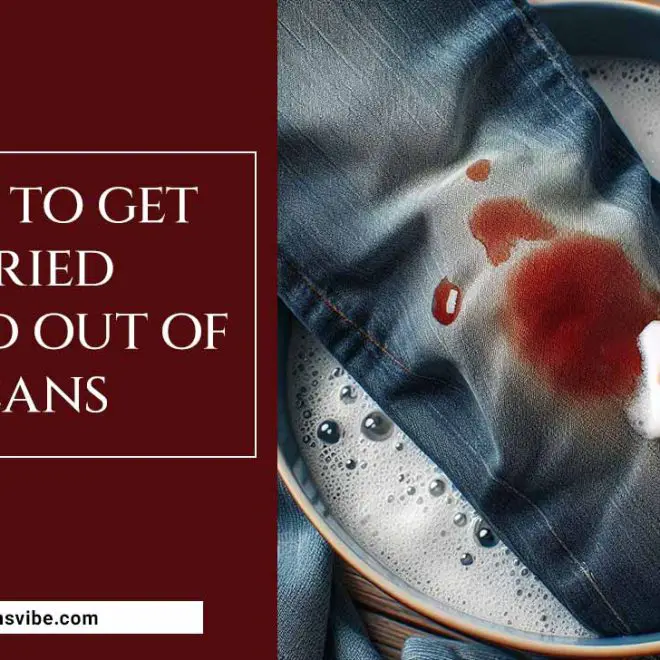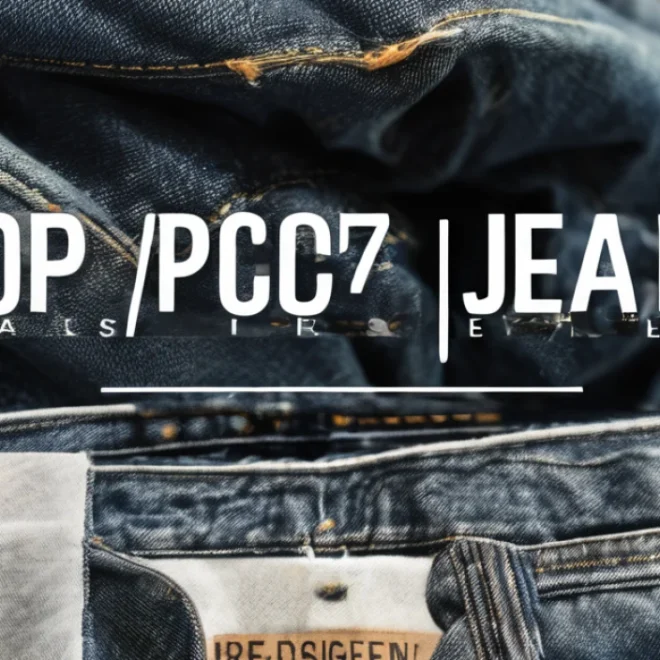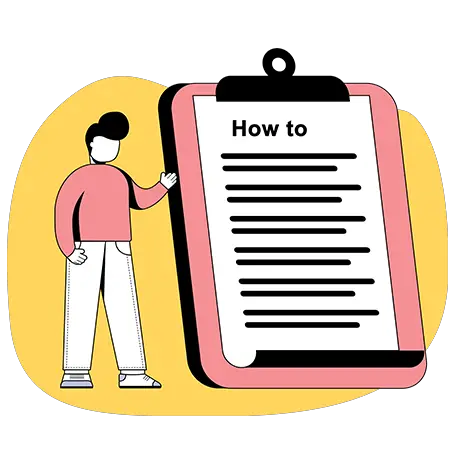Ripped jeans are a staple in many wardrobes, offering a stylish and edgy look. However, maintaining the distressed appearance while ensuring the jeans remain intact requires careful attention.
Proper care for ripped jeans is crucial to preserving their fabric integrity and unique design. Washing them incorrectly can lead to further tearing, fraying, or even complete loss of the distressed features that make them fashionable. Here are some essential tips for washing your ripped jeans without ruining them.

Preparing Your Jeans For Washing
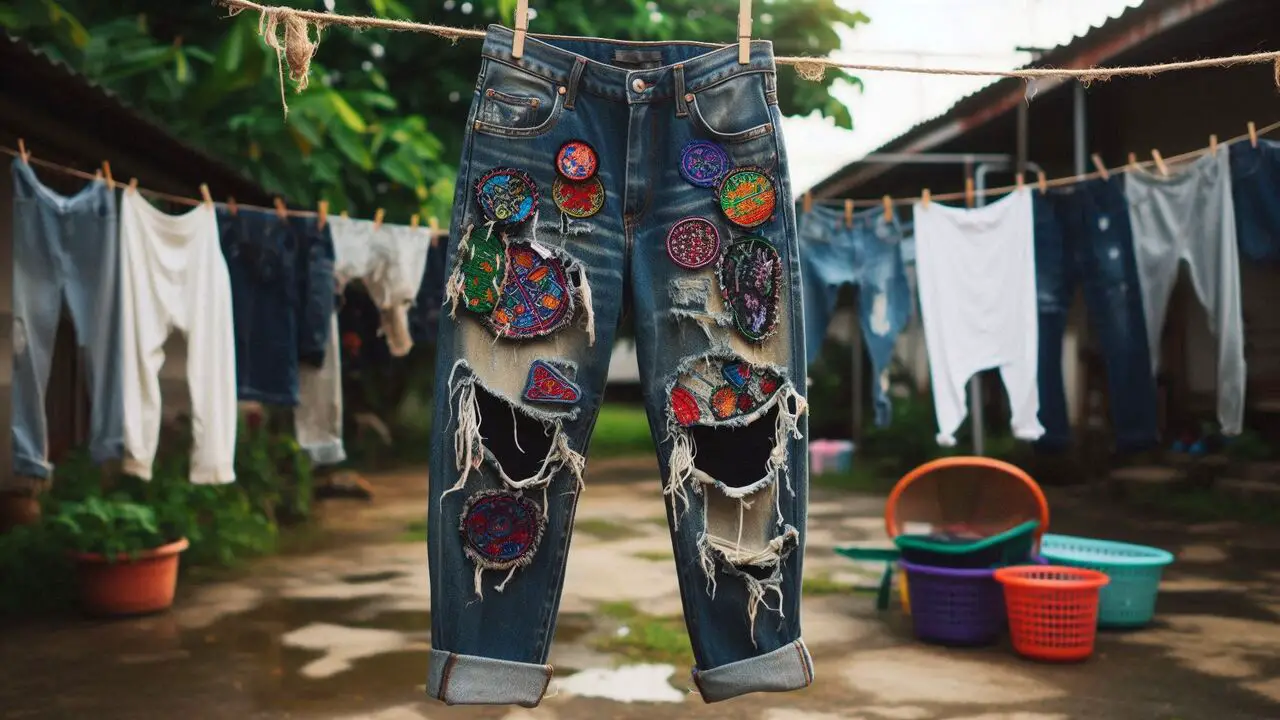
When preparing your distressed denim for washing, it’s crucial to take special care to preserve its unique look and prevent further damage. Start by inspecting the jeans for loose threads and reinforcing any weak areas to prevent the holes from expanding during washing.
Turn the jeans inside out before placing them in the washing machine; this protects the fabric and minimizes friction on the rips, helping to maintain their distressed appearance.
- Inspect for Loose Threads: Check for loose threads around the ripped areas.
- Reinforce Weak Areas: Stitch or patch weak areas to prevent further tearing.
- Turn Inside Out: Protect the distressed areas by washing your jeans inside out.
Choosing Mild Detergent
When washing ripped jeans, selecting the right detergent is essential to maintain their style and integrity. Mild detergents are ideal because they are less harsh on fabrics, helping to preserve the delicate fibers around the rips and distressed areas.
Unlike regular detergents, mild options avoid strong chemicals and enzymes that can weaken the fabric and cause additional fraying or damage. Additionally, many mild detergents are formulated to protect colors and prevent fading, which is crucial for keeping your jeans looking vibrant and well-maintained..
Selecting The Appropriate Wash Cycle
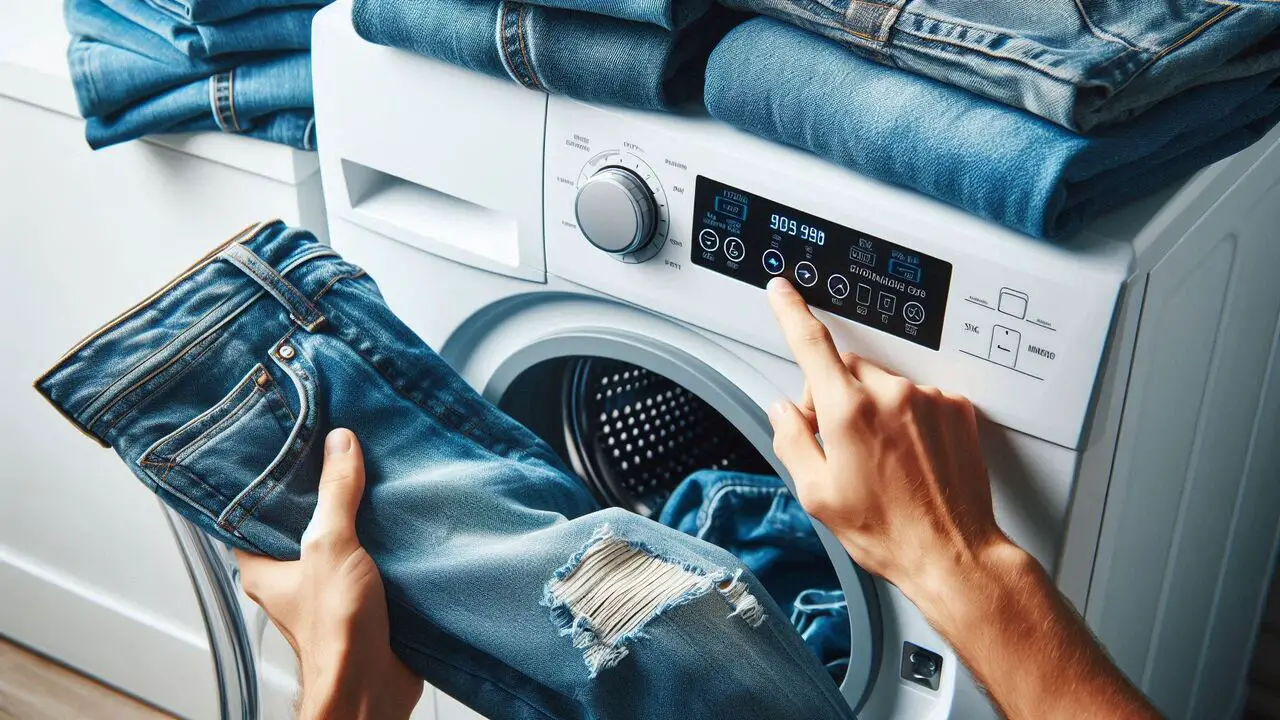
Opt for the gentle or delicate cycle, which minimizes agitation and friction, reducing the risk of further damage to the distressed areas. This cycle uses slower spins and milder tumbling, which helps prevent additional fraying and maintains the shape of your jeans. Avoid using the heavy-duty cycle, as it can be too rough and potentially exacerbate wear and tear.
Tips For Washing Ripped Jeans:

- Blue Jeans: Ensure you wash your blue jeans separately or in similar colors to avoid color bleeding.
- Denim Fabric: Ripped jeans are typically made from denim fabric, which is quite tough and can be worn out with what you prefer.
Hand Washing Method
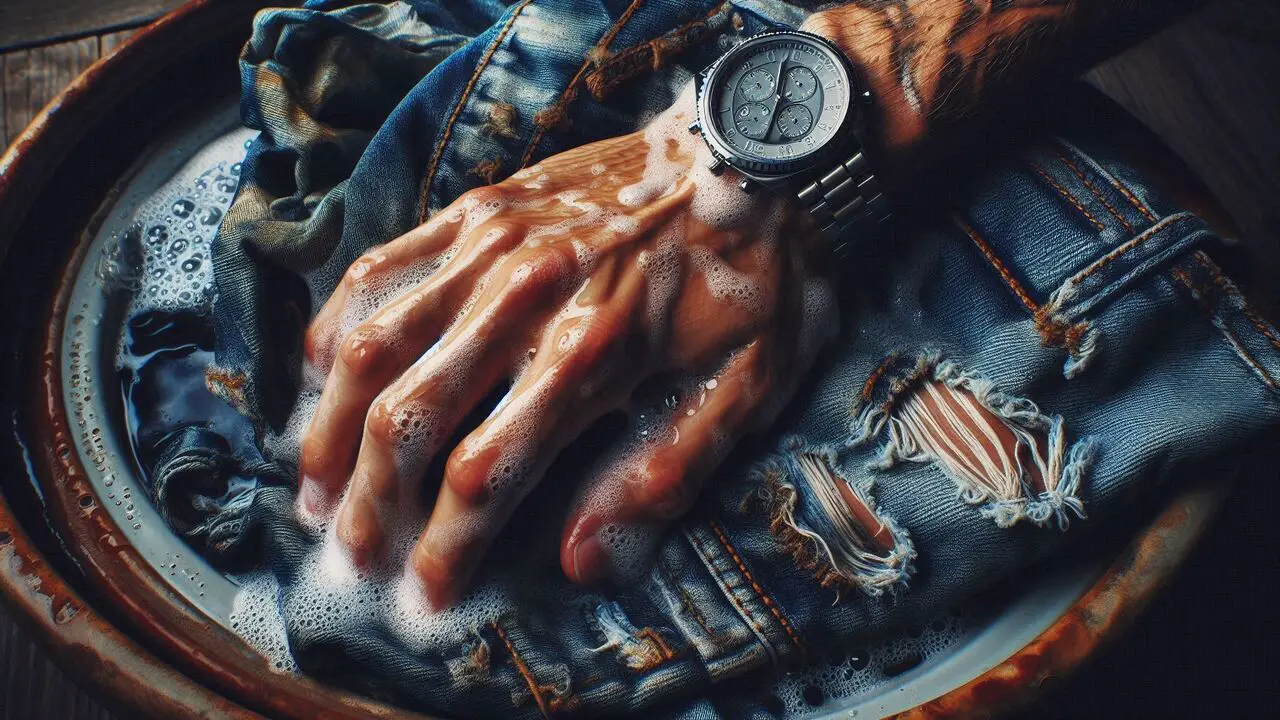
Ripped jeans, especially dark or skinny jeans, require extra care to preserve their distressed look and prevent further damage. Hand washing is ideal as it allows for gentler treatment and better control over washing conditions. Submerge the jeans in the soapy water and gently agitate them to loosen dirt. Let them soak for about 15-20 minutes to allow the detergent to penetrate.
Use a soft brush or cloth to spot clean around the ripped areas if needed, avoiding excessive scrubbing to maintain the distressed look. Rinse thoroughly & then remove excess water, hang them to air dry.
Benefits of Hand Washing Ripped Jeans:
- Preserves Distressed Look: Hand washing helps maintain the authenticity of distressed areas, preventing them from unraveling or becoming overly frayed.
- Gentle on Fabric: Hand washing minimizes wear and tear on the fabric by controlling the washing process, extending the life of your jeans.
Avoiding Fabric Softeners
Fabric softeners can harm ripped jeans as they can weaken the fibers further, causing the holes to expand and deteriorate faster. Instead of fabric softeners, you can maintain the softness of your old or favorite jeans by using alternative methods like a sewing machine to mend tears or reinforce weak spots. To soften the fabric, gently rub steel wool over the jeans to break down any rough patches.
Drying Your Ripped Jeans
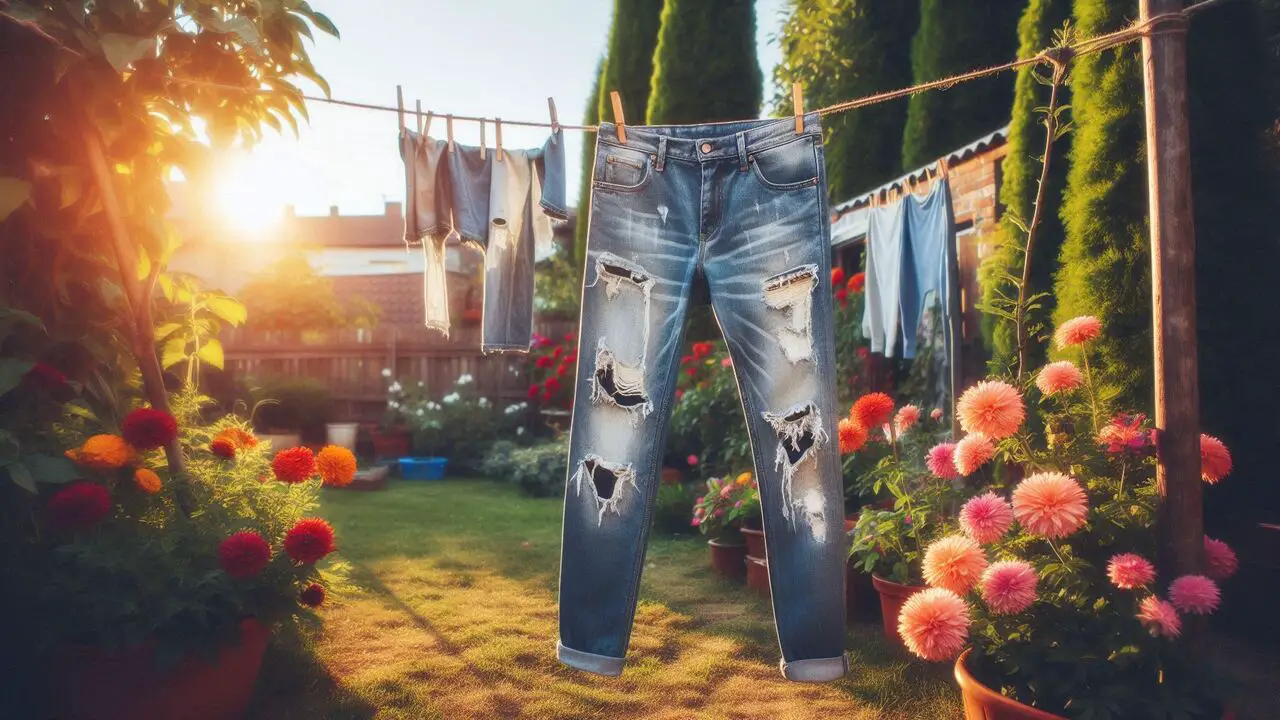
Ripped jeans, especially those with delicate fabric or dark denim, require careful handling during drying to preserve their integrity and prevent further damage. Air drying is crucial as it minimizes stress on the fabric around the rips and reduces the risk of stretching or enlarging the holes. The heat from dryers can cause the fabric to shrink or warp, potentially worsening existing tears or causing new ones.
- Lay Flat: Place jeans flat on a clean surface to retain shape and prevent stretching.
- Avoid Hanging: Hanging can stretch the fabric and distort ripped areas; use clips if necessary to minimize stress.
Tips For Maintaining The Distressed Look
- Avoid Excessive Washing: Limit washing to when absolutely necessary to prevent additional wear on the distressed areas.
- Spot Cleaning: Use a damp cloth or a soft brush to clean specific spots or stains gently.
- Air Dry: Hang your jeans to air dry instead of using a dryer, which can further stress the distressed areas.
- Store Carefully: Fold jeans neatly when storing to avoid further wear on the distressed parts.
Conclusion
In conclusion, washing ripped jeans requires a bit of extra care to preserve their unique style and longevity. By following these pro tips—such as turning them inside out, using a gentle cycle, and avoiding harsh detergents—you can keep your favorite pair looking fresh while maintaining their distinctive look.
Additionally, air drying rather than using a tumble dryer will help prevent further damage and maintain the integrity of the fabric. With these simple steps, your ripped jeans will stay stylish and durable for many wears to go.
Frequently Asked Questions
1.Can Bleach Be Used On Ripped Jeans?
Bleach is not recommended for ripped jeans, as it can further damage the fabric and worsen the rip. It can also cause discoloration and weaken the denim fibers. Instead, opt for a gentle detergent for denim or handwashing with cold water and mild soap.
2.Can You Wash Jeans With Holes In Them?
It is possible to wash jeans with holes in them. To prevent further damage, turn the jeans inside out before washing. Use a gentle cycle with cold water to avoid shrinking or fading. Avoid using bleach or fabric softener as they can weaken the fabric and worsen the holes.
3.How Do You Wash Ripped Jeans With Your Hands?
To wash ripped jeans by hand, fill a sink or basin with cold water. Add mild detergent and gently swirl the jeans in the water, focusing on the ripped areas. Let them soak for 15-20 minutes, drain the soapy water, and refill with clean water for rinsing. Press out excess water and air dry flat.
5.Can I Put Ripped Jeans In The Washing Machine, Or Should I Hand-Wash Them?
Putting ripped jeans in the washing machine is generally safe. To prevent further damage, turn your jeans inside out before washing. Use a gentle cycle and cold water to avoid shrinking or fading the denim. Afterward, air dry your jeans to prevent further tearing.
6.How Often Should I Wash My Ripped Jeans?
Washing ripped jeans less frequently helps preserve their fabric and prevent further distressing. It is recommended that they be washed every 4-6 wears unless they get noticeably dirty.
7.Can I Use A Dryer For My Ripped Jeans?
Using a dryer on low heat is generally safe for ripped jeans. However, air drying is gentler and helps maintain the distressed look longer.
8.What Should I Do If My Ripped Jeans Start To Fray Too Much?
If the fraying becomes excessive, you can trim loose threads carefully with scissors to prevent further unraveling. Applying fabric glue along the edges or sewing a patch underneath can also reinforce the area and prolong the life of your jeans.




